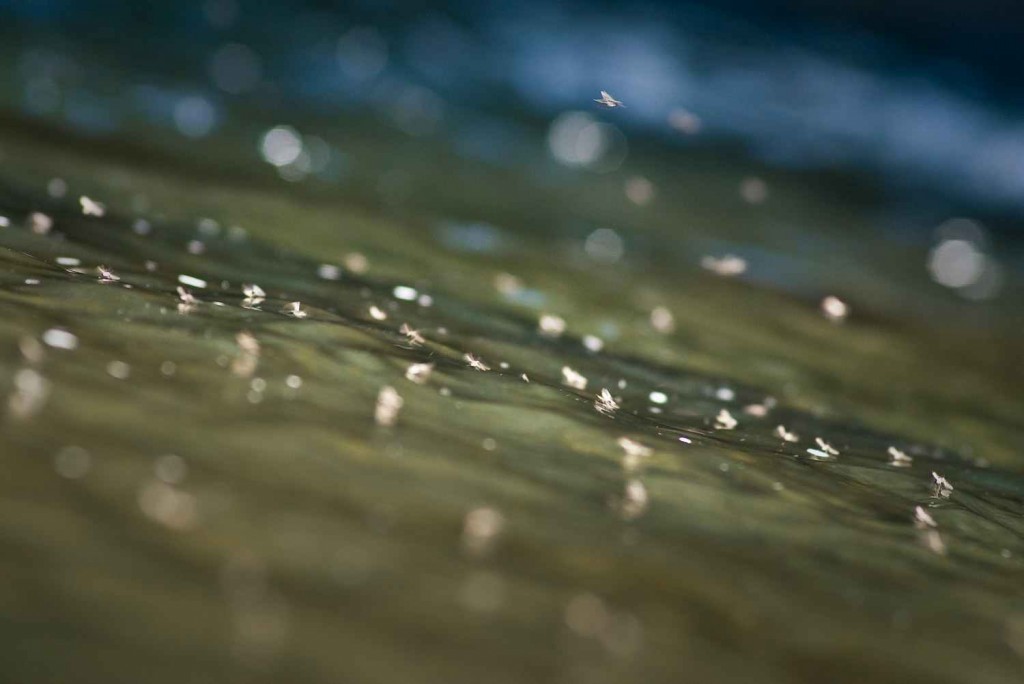Ever been on a trout stream during a blanket hatch and no matter how many times you drift your floating imitation over the rising fish, it’s ignored?
I’ve experienced this frustrating situation many times on the water. When this happened in the past, I used to think I was using the wrong pattern, or I was getting micro-drag during my drift or maybe my tippet was too large. Although one or more of these can often be the culprit of failing to get bites during a heavy hatch, it’s actually more common that you’re problem lies in the fact that you’re choosing to fish your fly on the surface instead of below the surface.
When hundreds or even thousands of bugs are on the water it makes your fly pattern very difficult to distinguish itself apart from all the other naturals on the water. Take for instance a trico spinner fall in late August or September. When in full swing, it can seem like almost every square inch of the water is covered with these tiny guys at times. Although many of them float long distances on the surface, eventually they will sink. Not all at once of course, just a portion of them here and there. When you choose to sink your fly pattern instead of floating it, you’re going to increase your chances of catching those feeding fish for three reasons.
1. You decrease the amount of competition between your fly and all the naturals.
By sinking your fly pattern below all the naturals on the surface your giving you’re pattern a much better chance of the fish spotting it. Below the surface there’s going to be far less naturals packed in close proximity to each other than on the surface.
2. The closer your fly is to the fish the easier it is for them to eat it.
By sinking your fly pattern, you’rr positioning your fly closer to the feeding fish. This gives you an advantage, because it makes it easier for the fish to eat your fly, and they don’t have to expend as much energy swimming all the way to the surface.
3. Smart fish often feed below the surface out of sight.
There’s always going to be a percentage of really smart trout, often the biggest, that prefer to feed below the surface, because it’s safer. They may not do so immediately but as the hatch or spinner fall begins to dissapate, and they become more and more aware of the impostors on the surface, they generally will transition towards feeding below the surface where they can forage in peace and remain undetected.
Next time you’re lucky enough to find yourself on the water during a dense hatch or spinner fall, don’t forget about sinking your fly if you’re not catching fish. Tie on a floating imitation and then drop a weighted version off the back. This will help you greatly in detecting strikes and also double your chances for hookups. You’ve got multiple options for tying up these sinking patterns. I opt for using two different methods for tying my sinking patterns. The first method, I simply tie the pattern on a heavier or larger hook. This works great when I just want my pattern drifting slightly below the surface. Situations for this would be when I’m fishing moderately shallow water or areas where I want to keep my fly from getting snagged on vegetation. The second method I use is weighting the fly with a bead or lead wraps along the hook shank. This works great in situations when I’m fishing fast moving water or need to get my fly deeper in the water column.
Keep it Reel,
Kent Klewein Gink & Gasoline www.ginkandgasoline.com hookups@ginkandgasoline.com Sign Up For Our Weekly Newsletter!

good read. I’ve always thought it’s easier for the fish to eat the rising nymphs under the surface…rather than exposing themselves by rising. It is wierd out there sometimes.
There are also very many adult forms of caddis flies and mayflies that are swimmers, they actually swim underwater to deposit there eggs on an object such as a Rock or vegetation.